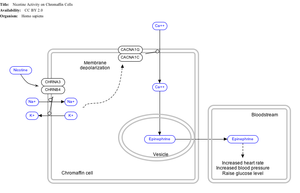Sulfoxaflor is a systemic insecticide which acts as an insect neurotoxin.
It is a derivative of Nicotine, which is highly poisonous:
"Nicotine
From Wikipedia, the free encyclopedia
This article is about the chemical. For other uses, see Nicotine (disambiguation).
 |
|||||||||||||||||||||||||||||||||||||||||||||||||||||||||||||||||||||||||||||||||||||||||||||||||||||||||||||||||||||||||||||||||||||||||||||||||||||||||||||||||||||||||||||||||||||||||||||||||||||||||||||||||||||||||||||||||||||||||||||||||||||||||||||||||||||||||||||||||||||||||||||||||||||||||||||||||||||||||||||||||||||||||||||||||||||||||||||||||||||
|---|---|---|---|---|---|---|---|---|---|---|---|---|---|---|---|---|---|---|---|---|---|---|---|---|---|---|---|---|---|---|---|---|---|---|---|---|---|---|---|---|---|---|---|---|---|---|---|---|---|---|---|---|---|---|---|---|---|---|---|---|---|---|---|---|---|---|---|---|---|---|---|---|---|---|---|---|---|---|---|---|---|---|---|---|---|---|---|---|---|---|---|---|---|---|---|---|---|---|---|---|---|---|---|---|---|---|---|---|---|---|---|---|---|---|---|---|---|---|---|---|---|---|---|---|---|---|---|---|---|---|---|---|---|---|---|---|---|---|---|---|---|---|---|---|---|---|---|---|---|---|---|---|---|---|---|---|---|---|---|---|---|---|---|---|---|---|---|---|---|---|---|---|---|---|---|---|---|---|---|---|---|---|---|---|---|---|---|---|---|---|---|---|---|---|---|---|---|---|---|---|---|---|---|---|---|---|---|---|---|---|---|---|---|---|---|---|---|---|---|---|---|---|---|---|---|---|---|---|---|---|---|---|---|---|---|---|---|---|---|---|---|---|---|---|---|---|---|---|---|---|---|---|---|---|---|---|---|---|---|---|---|---|---|---|---|---|---|---|---|---|---|---|---|---|---|---|---|---|---|---|---|---|---|---|---|---|---|---|---|---|---|---|---|---|---|---|---|---|---|---|---|---|---|---|---|---|---|---|---|---|---|---|---|---|---|---|---|---|---|---|---|---|---|---|---|---|---|---|---|---|---|---|---|---|---|---|---|---|---|---|---|---|---|---|---|---|---|---|---|---|---|---|---|---|---|---|---|
 |
|||||||||||||||||||||||||||||||||||||||||||||||||||||||||||||||||||||||||||||||||||||||||||||||||||||||||||||||||||||||||||||||||||||||||||||||||||||||||||||||||||||||||||||||||||||||||||||||||||||||||||||||||||||||||||||||||||||||||||||||||||||||||||||||||||||||||||||||||||||||||||||||||||||||||||||||||||||||||||||||||||||||||||||||||||||||||||||||||||||
Toxicology
See also: Nicotine poisoning
Historically, nicotine has not been regarded as a carcinogen and the IARC has not evaluated nicotine in its standalone form or assigned it to an official carcinogen group. While no epidemiological evidence supports that nicotine alone acts as a carcinogen in the formation of human cancer, research over the last decade has identified nicotine's carcinogenic potential in animal models and cell culture.[64][65] Nicotine has been noted to directly cause cancer through a number of different mechanisms such as the activation of MAP Kinases.[66] Indirectly, nicotine increases cholinergic signalling (and adrenergic signalling in the case of colon cancer[67]), thereby impeding apoptosis (programmed cell death), promoting tumor growth, and activating growth factors and cellular mitogenic factors such as 5-LOX, and EGF. Nicotine also promotes cancer growth by stimulating angiogenesis and neovascularization.[68][69] In one study, nicotine administered to mice with tumors caused increases in tumor size (twofold increase), metastasis (nine-fold increase), and tumor recurrence (threefold increase).[70] N-Nitrosonornicotine (NNN), classified by the IARC as a Group 1 carcinogen, is produced endogenously from nitrite in saliva and nicotine. The teratogenic properties of nicotine has been investigated. According to a study of ca. 77,000 pregnant women in Denmark,[citation needed] women who used nicotine gum and patches during the early stages of pregnancy were found to face an increased risk of having babies with birth defects. The study showed that women who used nicotine-replacement therapy in the first 12 weeks of pregnancy had a 60% greater risk of having babies with birth defects compared to women who were non-smokers.[citation needed] Tobacco use among pregnant women has also been correlated to increased frequency of ADHD. Children born to mothers who used tobacco were two and a half times more likely to be diagnosed with ADHD.[71] Froelich estimated that "exposure to higher levels of lead and prenatal tobacco each accounted for 500,000 additional cases of ADHD in U.S. children".[72] Effective April 1, 1990, the Office of Environmental Health Hazard Assessment (OEHHA) of the California Environmental Protection Agency added nicotine to the list of chemicals known to cause developmental toxicity.[73] In the Central Nervous SystemBy binding to nicotinic acetylcholine receptors, nicotine increases the levels of several neurotransmitters – acting as a sort of "volume control". It is thought that increased levels of dopamine in the reward circuits of the brain one of the major contributors of the apparent euphoria and relaxation, and addiction caused by nicotine consumption. This release of Dopamine induced by Nicotine is thought to occur via a cholinergic–dopaminergic link, mediated by a neuropeptide, ghrelin, in the ventral tegmentum.[88] Nicotine has a higher affinity for acetylcholine receptors in the brain than those in skeletal muscle, though at toxic doses it can induce contractions and respiratory paralysis.[89] Nicotine's selectivity is thought to be due to a particular amino acid difference on these receptor subtypes.[90]Tobacco smoke contains anabasine, anatabine, and nornicotine. It also contains the monoamine oxidase inhibitors harman and norharman.[91] These beta-carboline compounds significantly decrease MAO activity in smokers.[91][92] MAO enzymes break down monoaminergic neurotransmitters such as dopamine, norepinephrine, and serotonin. It is thought that the powerful interaction between the MAOIs and the nicotine is responsible for most of the addictive properties of tobacco smoking.[93] The addition of five minor tobacco alkaloids increases nicotine-induced hyperactivity, sensitization and intravenous self-administration in rats.[94] Chronic nicotine exposure via tobacco smoking up-regulates alpha4beta2* nAChR in cerebellum and brainstem regions[95][96] but not habenulopeduncular structures.[97] Alpha4beta2 and alpha6beta2 receptors, present in the ventral tegmental area, play a crucial role in mediating the reinforcement effects of nicotine.[98] In the sympathetic nervous systemNicotine also activates the sympathetic nervous system,[99] acting via splanchnic nerves to the adrenal medulla, stimulates the release of epinephrine. Acetylcholine released by preganglionic sympathetic fibers of these nerves acts on nicotinic acetylcholine receptors, causing the release of epinephrine (and noradrenaline) into the bloodstream. Nicotine also has an affinity for melanin-containing tissues due to its precursor function in melanin synthesis or due to the irreversible binding of melanin and nicotine. This has been suggested to underlie the increased nicotine dependence and lower smoking cessation rates in darker pigmented individuals. However, further research is warranted before a definite conclusive link can be inferred.[100]In adrenal medullaChemical IdentificationNicotine was first isolated from the tobacco plant in 1828 by physician Wilhelm Heinrich Posselt and chemist Karl Ludwig Reimann of Germany, who considered it a poison.[103][104] Its chemical empirical formula was described by Melsens in 1843,[105] its structure was discovered by Adolf Pinner and Richard Wolffenstein in 1893,[106][107][108][clarification needed] and it was first synthesized by Amé Pictet and A. Rotschy in 1904.[109]As an InsecticideTobacco was introduced to Europe in 1559, and by the late 17th century, it was used not only for smoking but also as an insecticide. After World War II, over 2,500 tons of nicotine insecticide (waste from the tobacco industry) were used worldwide, but by the 1980s the use of nicotine insecticide had declined below 200 tons. This was due to the availability of other insecticides that are cheaper and less harmful to mammals.[4]Currently, nicotine, even in the form of tobacco dust, is prohibited as a pesticide for organic farming.[110][111] In 2008, the EPA received a request, from the registrant, to cancel the registration of the last nicotine pesticide registered in the United States.[112] This request was granted, and after 1 January 2014, this pesticide will not be available for sale." Read the Eentire article at: http://en.wikipedia.org/wiki/Nicotine | |||||||||||||||||||||||||||||||||||||||||||||||||||||||||||||||||||||||||||||||||||||||||||||||||||||||||||||||||||||||||||||||||||||||||||||||||||||||||||||||||||||||||||||||||||||||||||||||||||||||||||||||||||||||||||||||||||||||||||||||||||||||||||||||||||||||||||||||||||||||||||||||||||||||||||||||||||||||||||||||||||||||||||||||||||||||||||||||||||||




























No comments:
Post a Comment